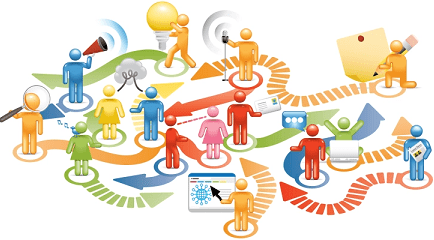
Today, small businesses are reshaping their strategies with a health and wellness focus. They're seeing the value of wellness programs in boosting employee engagement and happiness. By aligning with consumer trends, they are addressing the desire for healthier work environments.
Expanding Wellness Programs for Employee Engagement

To keep up with changes in the market and what workers expect, companies in the U.S. are adding more wellness programs. These programs are important because they help keep employees happy, engaged, and more likely to stay at their jobs. Adding health coaching and localized initiatives to these programs helps meet the health needs of individuals and communities.
Incorporating Localized Health and Wellness Initiatives
Localized wellness initiatives target specific health issues found in certain areas. For example, in busy places like Murfreesboro, TN, smaller companies are using these tailored programs to improve their community's health. This also makes employee engagement stronger. These programs often work with local health providers to offer workshops and health screenings that fit the local health trends. This approach makes employees healthier and feel like they belong to a community.
Offering Tailored Health Coaching Services
Custom health coaching is now key for many small companies looking to improve their wellness programs. Employees can talk one-on-one with certified health coaches about their health goals and issues. This personalized help is great for solving specific health problems. It also helps create a healthy culture at work. With a coach's help, employees can keep making healthy choices, which makes them happier and more productive at work.
Adding wellness programs, localized initiatives, and health coaching makes a workplace that supports everyone's health. It's not just about individual changes; it's about making the whole workforce healthier and more engaged. These efforts show that small businesses are investing in their employees' well-being, which benefits everyone, inside and outside the office.
Investing in Health and Wellness for Growth and Retention

Businesses now see the big plus of putting money into health and wellness. This move is key for growing and keeping their team. Investing in health and wellness helps the whole work vibe. It makes employees happier and boosts the company's success.
When companies pay attention to health benefits, they notice a lot of good changes. Employees feel better, work harder, and stay loyal.
Let's look at the ways businesses benefit from taking care of their teams' health:
- Enhanced Employee Performance: Healthier employees do a better job. Health programs cut down sick days and lower healthcare costs over time.
- Attracting Top Talent: Quality health benefits make a company stand out to job seekers. Those with great wellness programs draw in the best workers.
- Creating a Positive Work Environment: A health-focused workplace leads to a stronger, happier work culture. It helps keep turnover rates down.
- Better Employee Engagement: Wellness programs that match what employees need boost their involvement. Cared-for employees are more dedicated and loyal.
Putting in place great health and wellness programs isn't just spending money. It's a clever investment in health and wellness that makes the team and workplace better. It helps keep staff around and makes the company a great place to work, helping with both happiness at work and company growth.
Adopting New Wellness Products and Services

The market for wellness products and fitness services is growing fast. Businesses now aim to promote healthier, more active ways of living. They carefully choose products to meet different consumer needs. This is key to keep up in the quick-moving market.
Curating Wellness Product Lines for Diverse Needs
Choosing wellness products carefully is crucial. It ensures there's something for everyone's health needs. Whether it's for losing weight or reducing stress, quality matters. Small businesses are catching on. They offer unique wellness solutions tailored to their customers.
- Monthly subscription boxes featuring a curated selection of health supplements and fitness gadgets.
- Specialized kits tailored for home-based workouts and mindfulness practices.
- Eco-conscious products that support sustainable living and personal well-being.
Integrating Fitness Services to Promote Active Lifestyles
Adding fitness services to the daily mix is vital. It encourages a life filled with activity. These efforts aim to boost both physical health and mental wellness, very important in our busy world.
In fact, promoting fitness can help address the growing concerns about mental health in the workplace, as discussed in the article "The Silent Epidemic Of Mental Health In The Workplace."
Fitness programs now fit into everyone's hectic schedules. They give employees and clients chances to be healthy smoothly.
- On-site fitness classes and workshops, making it more convenient for employees to engage in physical activity without having to leave the work place.
- Collaborating with local fitness centers to offer discounted memberships tailored for small business clients and their employees.
- Virtual reality fitness experiences that can be accessed remotely, enabling users to engage in immersive wellness activities from the comfort of their homes.
Spending on wellness products and fitness services highlights their growing role in business. It ensures people can live actively and focus on health.
The Rise of Lifestyle Brands in Workplace Wellness

Lifestyle brands have changed the game in workplace wellness. They bring consumer lifestyle choices right into the workday. These brands do more than sell products. They champion a healthy living culture. Small businesses are catching on, seeing value in connecting their work to these wellness trends.
By embracing the ethos of lifestyle brands, small businesses boost their appeal. They create environments where employees are happy and productive. Aligning with these values means tapping into the demand for a balance between work and wellbeing.
- Employee Engagement: Companies adopting the ethos of lifestyle brands often see higher levels of employee engagement. This is because employees feel that their personal health goals are supported and valued.
- Attraction and Retention: Businesses reflecting lifestyle brand values are likely more adept at attracting and retaining talent, especially among sectors where competition for skilled labor is high.
- Innovation: Infusing lifestyle brand principles can drive innovation, pushing companies to develop new and unique ways to integrate wellness into everyday business operations.
Lifestyle brands have made a big impact on workplace wellness. They match consumer lifestyles, making health a key part of their identity. Employers and employees both benefit from this focus on wellness.
Health and Wellness as a Competitive Edge in Business

In today's fast-paced market, having a competitive edge is key. Integrating health and wellness programs into a business plan helps a lot. This makes employees happier and more productive. It also attracts potential hires and investors. By focusing on health and using HR tech, companies gain big.
Utilizing HR Tech for Streamlined Health Management
HR tech has changed how companies handle employee health. With automated systems and AI support, managing health gets easier. For example, CoAdvantage uses advanced HR tech to help small businesses. They make tasks like payroll and health management simpler. This lets businesses grow without neglecting employee health.
Employing Data Analytics for Health-Focused Business Decisions
Data analytics is key in planning health and wellness programs. It lets companies customize their health plans to fit employees' needs. PolicyMap offers insights on local health and economic conditions. This helps in making wellness strategies that really work. A well-targeted plan improves a business's reaction to market changes.
Using HR tech and data analytics helps in two big ways. It keeps the workforce healthy and strengthens the company's position. This approach shows the company values employees and smart business practices. It helps companies not just survive, but do really well in tough markets.
Consumer Trends Shaping the Future of Health and Wellness

In the world of health and wellness, keeping up with consumer trends is key for success. The future of health and wellness is being shaped by how well companies use market intelligence. This knowledge helps them create products and services for an educated consumer group.
- Now, consumers want more than a simple product. They are looking for a service that improves their overall lifestyle in every way.
- Access to big data lets companies understand their customers better. This ensures their products meet the consumers' needs in real time.
- Being eco-friendly is now more important in consumer choices. Businesses that consider the environment in their products stand out from the rest.
Companies like PolicyMap are offering tools to make sense of complicated data. This is especially helpful for small and midsize firms. With PolicyMap's tools, these firms can dig into health trends and adjust their strategies to fit them.
- By knowing what different regions prefer, businesses can make their health programs match local interests. This builds consumer loyalty.
- Adding modern technology to wellness products makes them more appealing. It also keeps them up-to-date with what consumers expect.
In conclusion, the competition in the health and wellness industry is intense. The firms that can swiftly adapt to consumer trends will lead the market. Success depends on using market intelligence for constant improvement and learning. This approach is crucial in the evolving future of health and wellness.
Harnessing Community Resources for Business Innovation

Combining community resources with an entrepreneurial mindset leads to innovation, especially in health and wellness. Public libraries play a key role. They give people and small businesses tools to grow. Libraries are now centers for business growth, offering resources and encouraging teamwork. This makes it easier for future entrepreneurs and community leaders to research and plan their health and wellness ventures.
PolicyMap's project is another step forward. It gives library users access to a wealth of data. These collaborations help with data-driven business and community plans. PolicyMap lets users look into local demographics, health trends, and economic data. Having this kind of information helps plan health programs or start wellness businesses that meet local needs.
Using community resources like libraries and PolicyMap shows the importance of making informed choices in business innovation. This blend of public and private efforts boosts the economy and improves community health. By using these resources, individuals can create projects that help their communities, connecting profit and purpose.
What do you think is the most important benefit of having health and wellness programs at work?









